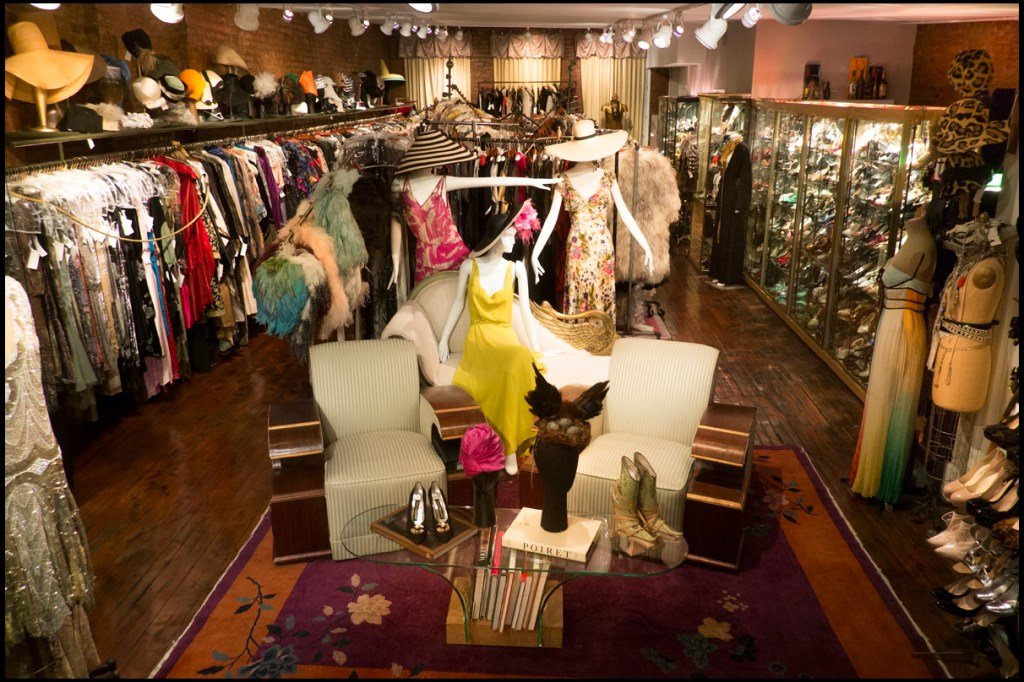Fashion
Shopping tours in New York City help move vintage fashion forward
In the fashion archives at New York Vintage, a swanky vintage couture shop in Manhattan’s Chelsea neighborhood, I tried on a pair of 1980s bird cage earrings worn by Madonna in a provocative shoot for Vanity Fair Italia in 2023. These dangling works of art are too heavy to be practical, but what a glamorous look.
Of course, nothing here is meant to be practical. Much of the extensive collection is over the top. Think metallic gold and green platform shoes ready to boogie on down to Studio 54, Vegas-style feathered headpieces suited to a 1950s showgirl and a fuchsia midriff-baring dress reminiscent of Carmen Miranda.
In the retail shop, vintage styles by designers such as Christian Dior and Yves Saint Laurent await; anyone is welcome to shop the collection. But upstairs, private archives that span more than a century of fashion have always been off limits to those outside the fashion and entertainment industries — until now.
“Step into the World of Iconic Style: A Private Tour of Vintage Fashion Archives” was recently launched by Shannon Hoey, owner of New York Vintage. Now, anyone can book an appointment to peruse this virtual museum of style; but unlike at a museum, visitors can touch the artifacts and even make TikTok videos of themselves modeling pieces worn by Rihanna, Cardi B, Lady Gaga and Beyoncé.
This rental-only showroom is a treasure trove for celebrities and their stylists in search of flamboyant pieces that bring drama to the stage, music videos and magazine covers.
Hoey often assists in the selection process. She calls herself a “stylist to the stylists.”
“They will send me a mood board, and I’ll curate a selection of pieces,” Hoey said. “I can save them hours of work. There have been countless editorials where I’ve done the pre-selection, and they used everything.”
When Lady Gaga, the queen of wacky fashion, was contemplating her next outrageous look, Hoey provided a beaded bra that once belonged to Josephine Baker.
Some pieces sourced from New York Vintage are now cultural icons, such as the bird of paradise headpiece Carrie Bradshaw (played by Sarah Jessica Parker) wore for her wedding-that-wasn’t in the 2008 film “Sex and the City” and in an episode of the follow-up series “And Just Like That.”

The 19th century accessory was sold at Sotheby’s Fashion Icons sale in 2023, as was a black Norman Norell dress Michelle Obama wore to a 2010 Christmas event, evidence that not everything sold at New York Vintage is eccentric pop star fodder.
When Obama appeared in the 1950s lace dress featuring a full skirt and square neckline, she made history as the only American first lady to wear a secondhand dress in public. The country was clawing its way back from a recession, so it seemed appropriate that one of the most influential women in America should eschew high-end designers in favor of understated, mid-century elegance — proof that fashion and moderation can coexist.
My own love of retro style blossomed around the same time the first lady debuted her nostalgic look, long before vintage shopping was mainstream. I’ve worn my share of dresses with swirly skirts and fitted bodices that channel Doris Day and Grace Kelly, so an opportunity to hit Chelsea’s second-hand stores was a dream come true.
Today, secondhand shopping is a badge of honor for those who value sustainability and a low carbon footprint. Whether shoppers are in the market for couture or everyday street wear, thrift stores are an antidote to fast fashion, a culture of cheap, disposable clothing that causes environmental harm on a grand scale.
Nobody understands the shift toward sustainability in fashion better than Samantha “Sammy” Davis, personal shopper and owner of The Ultimate NYC Secondhand Shopping Experience.

“Sustainability has become so much more than just a buzzword,” Davis said. “It’s a lifestyle choice. Secondhand treasures of high quality and natural fibers stand the test of time and help contribute to a less wasteful world.”
I met up with Davis, who was rocking a kimono upcycled from a secondhand duvet, at the new NH Collection New York Madison Avenue hotel where I was staying. We walked the 13 blocks (New Yorkers are used to hoofing it!) to what Davis calls “Thrift Row,” a stretch of secondhand shops on West 26th Street.
Along the way, our group stopped at Chelsea Flea, a long-standing weekend flea market that was a favorite haunt of Andy Warhol’s back when Chelsea was known more for its gritty, Bohemian vibe than high-end art galleries and luxury apartments.
I scored a 1960s bracelet encrusted with a pair of sparkling rhinestone cats that seem to “kiss” when the bracelet is snapped into place. Not a single rhinestone was missing, a testament to the superior craftsmanship found even in costume jewelry back in the day.
Environmentally conscious Gen Z and millennials comprise a sizable portion of the secondhand shopping base nationwide, but Gen Xers like me, and even boomers, are getting on board with the sustainable fashion movement.

Davis jokes that she’s a “secondhand soothsayer,” able to read a person’s style. A pre-tour consultation helps her guide shoppers to affordable finds on point with their aesthetic. She’s had requests for everything from tuxedos to cowboy boots.
More than 20 stores jammed with merchandise can feel like an incomprehensible maze, so Davis curates an effortless experience where buyers just follow her lead.
“It can be overwhelming for the novice, but things are categorized by item and size,” Davis said. “I’ll guide them to one section based on what they are shopping for. If you try to hit all the sections, your mind is going to be spinning.”
After all, if you’re hoping to snag a designer gown, you don’t want to spend time combing through secondhand Gap dresses.
By the third store, I thoroughly appreciated the personal shopper concept. This alternate universe where Oleg Cassini is slumming it a rack away from H&M discards threatened to make my vintage hat-wearing head explode. Sensing my confusion, a smiling Davis guided me to the designer handbags I had expressed an interest in.

A life-size statue of Elvis coaxed us into Flamingo’s Vintage Pound. As the name suggests, clothing is sold by the pound. Vintage enthusiasts get all shook up over finds such as Harley-Davidson motorcycle jackets and T-shirts emblazoned with the name of their favorite band.
Our whirlwind tour continued to 2nd Street, the Japan-based secondhand retailer that sells Japanese designer brands, such as Issey Miyake, as well as international luxury goods. High-end clothing and accessories are easily spotted in the front of the store, whereas more affordable items are in the back.
Next, we hit Garage Sale Vintage. This store is more than a place to pick up cool retro threads; it’s a party with tacos and tequila. Spend $100 and you get a free shot at the in-store bar.
At the end of this shopping extravaganza, everyone lugged home their bargains in reusable tote bags, backpacks and even suitcases — no single-use plastic bags.
I felt a sense of satisfaction that I had done my part to kill fast fashion and save the planet, and had a blast doing it. My feet were sore, but my conscience was clear.
Tracey Teo is a freelancer.

